|
Date
|
Speaker
|
Topic
|
Faculty Host
|
11/16/2012
126 MH
|
Page Moreau
Colorado
|
"The Influence of Identity Activation on Consumers' Evaluations of their Own Creative Products"
-
Click to read Abstract
In both on-line and off-line contexts, consumers are creating a wide range of unique products for themselves including original art, customized shoes, home decor, and digital scrapbooks. When designing these products, consumers rely on different sources of knowledge and experience for inspiration. One of the most influential of these sources is the consumer's own identity. Tapping into this source allows consumers to infuse the creative product with elements that reflect who they are - their personality, tastes, history, relationships and values. As Belk states, "the idea that we make things a part of self by creating or altering them appears to be a universal human belief" (1988, p.144). Thus, it is surprising that few academics have examined the relationship between identity and creativity in great depth.
Identity is a complex knowledge system containing the traits, behaviors, goals, and other information that constitute an individual's understanding of who they are (Cheng, Sanchez-Burks, and Lee 2008 James and Eisenberg 2004: Oyserman 2009). An individual's overall identity is usually comprised of a number of personal and social identities, yet it is usually just one of them that governs thoughts and behaviors at any given point in time (James and Eisenberg 2004 Markus 1987 Oyserman 2009). For consumers engaged in a creative task, we propose that this active identity will have a disproportionate influence on the content and composition of the creative product. Thus, our research is designed to understand how the activation of an identity influences consumers' evaluations of their own creative products. We further examine whether this relationship depends upon the nature of the creative task.
The Nature of the Creative Task
Consumers engage in a wide range of creative tasks which vary substantially in terms of the amount and type of creative thought required. One dimension that differentiates these tasks is the degree to which the process is structured. At one extreme, the creative task is governed by a full set of step-by-step instructions at the other extreme, the process by which the creative task is accomplished is completely unspecified (Dahl and Moreau 2007.
In the literature on consumer creativity where the creative task tends to be relatively unstructured (e.g., design a toy, fix a scuffmark, knit a sweater, invent a new drinking glass), researchers have demonstrated that input constraints increase the judged creativity of a product (Burroughs and Mick 2004 Goldenberg, Mazursky, and Solomon 1999 Moreau and Dahl 2005 Sellier and Dahl 2011). However, in the literature on customization, where the creative process is structured by an online toolkit, input constraints have been shown to decrease the value that the product holds for the creator (Franke, Schreier, and Kaiser 2010). Given that two significant factors vary across these sets of studies (the degree to which the process is structured and the dependent variable of interest), it is difficult to draw general conclusions as to the value of using process and input constraints for creative endeavors.
Thus, in our research, we hold the dependent variable constant across three studies and examine how process structure and input constraints influence the meaning and value consumers create in a product when an identity is activated. The first study engages participants in an unstructured creative task (i.e., drawing a picture) and demonstrates that input constraints enhance evaluations for those with an identity active but reduce evaluations for those without an active identity. The second study then reverses these effects in a structured creative task (i.e., designing a T-shirt with an on-line toolkit). Finally, the third study delves deeper into the relationship between identity and evaluations by isolating different identity motivations (personal and social) in a structured creative task (i.e., designing a customized mug with an on-line toolkit). This study further demonstrates the mediating role of product meaning in explaining both evaluations at the time of the creative task and satisfaction with the delivered product six weeks later.
|
|
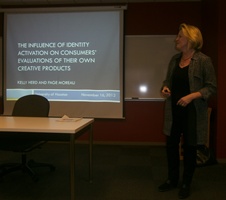
|
11/2/2012
126 MH
|
Carl Mela
Duke
|
"Hyper Media Search and Consumption"
-
Click to read Abstract
In the past ?ve years, the number of Americans using the Internet as their main source of news has doubled to more than 40%, while those choosing newspapers has dropped to just over 30%. Although this trend signals a shift in the consumption of information in favor of hyper-media, wherein excerpting and linking is commonplace, research regarding how consumers acquire news in online environments has not proceeded apace. We develop a model of forward-looking consumers who gain knowledge and utility through the search and consumption of hyper-media, and explore its implications for welfare and site policy.
The model is estimated using comScore browsing data for ?ve celebrity news and gossip sites, supplemented with link data scraped from site archives. The model is estimated by coupling Imai, Jain, and Ching's (2009 Econometrica 77(6):1865-1899) method with the Riemann manifold sampling algorithm of Girolami and Calderhead (2011 JRSS-B 73(2):123-214). The pairing of these recent advances enables researchers to estimate dynamic models with many more variables and states than previously considered.
Results indicate consumers are heterogeneous in their preferences for certain types of celebrity sites (e.g., females prefer sites that emphasize gossip over pictorials of female models and entertainers). Results also indicate that links to other sites are informative about the target site's potential quality after observing one link to another site, consumers' uncertainty about the linked site's quality is about 20% lower.
Counterfactual analyses show that network throttling, in which access to all sites is slowed down uniformly in an effort to reduce congestion, has an unequal effect on site traffic. For example, sites frequented by consumers with higher than average browsing costs lose a greater share of their traffic. They also show how a change in fair use law, in which excerpts and links become less informative of the linked sites' quality, causes consumers with more extreme tastes to curtail their searches, consequently decreasing traffic at sites with mainstream content and many inbound links. A third counterfactual experiment uses the model to explore the implications of pay walls for site traffic.
|
|
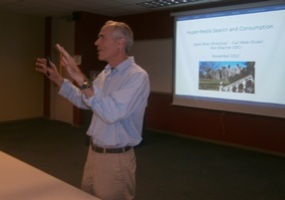
|
10/26/2012
213 MH
10:00-11:30 AM
|
Anne Coughlan
Northwestern
|
"Wardrobing: Is It Really All That Bad?"
-
Click to read Abstract
In a 2008 survey, about 64% of U.S. merchants experienced "wardrobing" behavior by consumers buying their items (Barnard 2009). An item is said to have been "wardrobed" when it is bought by a consumer used for a short time and then returned to the store as if it were unused, for a full or partial refund (Enkoji, 2009, Segal 2010). Products such as a Halloween costume, a set of tools for a one-time home improvement job, a wedding dress, a video projector for use in a business meeting, or a TV to watch the Super Bowl can be wardrobed, for example. Since these returned products cannot later be sold as new, many retailers resort to identifying them as "open-box" items when they are put back on the retail shelf, with a concomitant requirement to lower the price of these products.
The existing academic literature suggests that this type of opportunistic buyer behavior is a threat to retailer profitability and should be fought by awarding only a partial refund for returned products as the level of opportunism increases, so should the restocking fee (Chu et. al 1998). Wardrobing is also interpreted as evidence of moral hazard that results in increased retailer costs, which can be avoided by an efficient money-back contract that takes consumers'''''''' incentive to engage in moral hazard into consideration (Mann et al. 1988).
This paper considers the benefits and costs of wardrobing by analyzing an analytical model of a retailer selling one product over two periods in a heterogeneous market. Specifically, a "regular" consumer belongs to a segment assumed to derive positive (but heterogeneous within the segment) value from the product in both periods when s/he buys the product in the first period and holds it over both periods (s/he could of course also choose to wait to buy until the second period, then deriving positive usage value only in the second period). Meanwhile, the "opportunistic" consumer belongs to a segment assumed to derive positive (but again, heterogeneous within the segment) usage value from the product only in the first period (for example, during a wedding weekend during Super Bowl weekend etc.). If a member of the opportunist segment buys at all, s/he buys a new product in the first period and, if allowed to do so, returns it in the second period for a refund.
With this segmentation structure, our research shows that the retailer always prefers to allow wardrobing by serving the opportunist segment that buys and then returns the product, if price pre-commitment is not possible. This finding stands in direct contrast to the business press attitude that wardrobing is universally unethical, fraudulent, or otherwise criminal, as well as harming retail profit. We show that wardrobing is in fact not entirely bad because it offers the retailer the ability to practice price discrimination among "regular" segment consumers who vary in their product usage valuations. In contrast to the previous literature, this paper thus shows that retailers should not always try to squelch wardrobing behavior, but should instead encourage the opportunist segment to purchase and return the product by offering low restocking fees when commitment to future pricing levels is not feasible. We show conditions under which the retailer would prefer to employ wardrobing without price commitment, to a situation where price commitment is possible and wardrobing is not used thus we establish the role of wardrobing as a substitute for - and sometimes a superior alternative to - price pre-commitment. We also show that the retailer optimally caters to an opportunist segment of wardrobers, rather than internally producing "open-box" units by slashing its own units for sale thus, the retailer does rely on this extra segment of consumers to optimize its multi-period pricing and sales strategy. Our research also provides a new theoretical explanation for the low (sometimes even zero) restocking fees charged by retailers, even during periods with high levels of wardrobing behavior (e.g., directly before Super Bowl weekend).
|
|
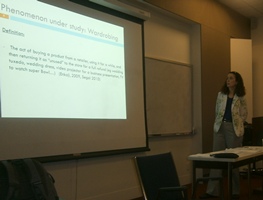
|
10/22/2012
213 MH
10:00-11:30 AM
|
Adriana Madzharov
Baruch
|
"The Cool Scent of Power: Effects of Ambient Scent on Consumer Preferences and Choice Behavior"
-
Click to read Abstract
Sensory marketing or employing sensory-stimulating techniques in order to fully engage consumers' senses and enhance the consumption experience, has recently received growing interest from both practitioners and consumer researchers. According to industry managers, one area in particular that holds wide and unexplored opportunities and much commercial promise is scent marketing, or emitting ambient scents in the service environment. Despite practitioners' evolving interest and a rapid investment increase in ambient scent technologies, consumer research on scent has been very limited. Extant research still leaves many important questions unanswered for instance, how ambient scent, as a valued atmospherics tool, might affect perceptions of retail density, an environmental factor of main importance for consumer evaluations and behavior in the shopping context. Importantly, consumer research on scent is still silent on the effects that ambient scents have on main marketing variables such as product choice, preference, and willingness-to-pay.
In the present work, I contribute to furthering our understanding of how ambient scents affect consumer perceptions and behavior by providing an in-depth exploration of how semantically-related scent categories affect product choice and preferences. Extant research from psychophysics and psychology has established that certain scents can produce warming or cooling sensations and carry strong associations with warmth or coldness. For example, some scents are perceived as warm scents (e.g., cinnamon, vanilla) while others are perceived as cold scents (e.g., peppermint, eucalyptus). In the present research, I develop and test a model in which scents that differ on the temperature dimension produce judgment biases on perceptions of social density that ultimately lead to power-compensatory consumption behavior. In four studies, I demonstrate that a warm (vs. cold) scent leads to perceptions of greater number of people present, greater physical proximity between people, and perceptions of more limited space. Importantly, I demonstrate that in a warm (vs. cold) scent and perceptually more socially dense environment, people exhibit greater willingness-to-pay for high-status products, higher evaluations of prestige (vs. performance) qualities of products, and desire for more choice.
These findings carry important theoretical contributions to sensory research as well as practical implications useful to marketing managers. This research is the first to demonstrate that sensory stimulation from ambient scents can produce biases on perceptions of social density thus contributing to both streams of research on sensory marketing and spatial perception. In addition, I extend research on luxury consumption in consumer behavior by identifying an antecedent factor in the consumer environment that can lead to preference and choice for high-status products. The present findings also have wide managerial implications relevant to retail and service settings. The present results can provide practitioners with strategic guidance on how to select appropriate scents in order to meet their specific goals in particular shopping environments and situations.
|
|
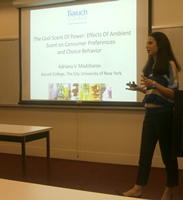
|
10/19/2012
126 MH
10:00-11:30 AM
|
Oded Netzer
Columbia
|
"Dynamic Targeted Pricing in B2B settings"
-
Click to read Abstract
We model the multifaceted impact of pricing decisions in B2B contexts and show how a seller can develop optimal inter-temporal targeted pricing strategies to maximize long-term customer value. We empirically model the B2B customer's purchase decisions in an integrated fashion. In order to facilitate targeting and to capture the short and long-term dynamics of B2B customer purchasing, our modeling framework weaves together in a hierarchical Bayesian manner, multivariate copulas, a non-homogeneous hidden Markov model, and control functions for price endogeneity. We estimate our model on longitudinal transactions data from an aluminum retailer. We find that customers in our dataset can be best represented by two latent states - a "vigilant" state characterized by heightened price sensitivity and a cautious approach to ordering, and a more "relaxed" state. The seller's pricing decisions can transition customers between these two states. An optimal dynamic and targeted pricing strategy based on our model suggests a 52% improvement in profitability compared to the status quo. Furthermore, a counterfactual analysis which examines the optimal policy under fluctuating commodity prices reveals that the seller should pass much of the costs to customers when commodity prices increase, but hoard most of the profit when commodity prices (seller's costs) decrease.
|
|
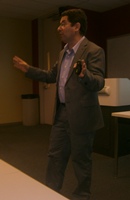
|
10/12/2012
126 MH
10:00-11:30 AM
|
Melanie Rudd
Stanford
|
"Being Present: Expanding Perceptions of Time through Momentary Temporal Focus"
-
Click to read Abstract
Consumers today often find themselves struggling to keep up with the hectic pace of everyday life and meet the expectations of a society that currently places an extremely high value on time. Many, in fact, perceive themselves to be victims of a ?time famine?, feeling that there is too much to do and not enough time to do it (Perlow, 1999). And despite technological innovations that have automated many daily tasks, this time shortage problem has only worsened in recent years. Indeed, a perceived lack of time availability now may be one of the most pervasive experiences in modern society. A recent poll of over 1,000 Americans found that nearly half (47%) felt they lacked enough time in daily life (Carroll, 2008), and the percentage of adult Americans who report feeling ?always rushed? has been increasing (Robinson & Godbey, 1997). And unfortunately for consumers, research has indicated that time shortage can negatively impact health and well-being (Menzies, 2005) and have other undesirable effects, such as encouraging greater consumption of fast food and multitasking while driving (Darian & Cohen, 1995 Nationwide Mutual Insurance Company, 2008). So, what can be done to shift consumers' perceptions of how much time is available and make them feel more time affluent?
I posited that consumers' momentary temporal focus (i.e., the extent to which they are currently focused on the past, present, and future) is capable of altering time perception. Specifically, I examined how a stronger focus on the present expands perceptions of current time availability. Across the three essays of my dissertation, I demonstrate not only that this heightened focus on the present (and the resulting perception of greater time availability) can be attained in a variety of ways, but also that perceived time affluence has important consequences for consumer decision making and well-being.
|
|
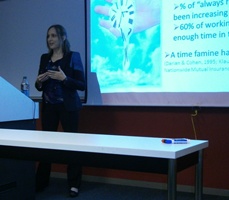
|
10/8/2012
213 MH
10:00-11:30 AM
|
Szu-Chi Huang
UT Austin
|
"Motivational Consequences of Perceived Velocity in Consumer Goal Pursuit"
-
Click to read Abstract
The authors explore the interplay between consumers' progress levels toward attaining a goal and the perceived velocity in progressing toward the goal to determine consumers' motivation for further goal pursuit. The authors propose that when progress toward attaining a goal is low, consumers are primarily concerned about the question "Can I get there?" Thus, a high (vs. low) perceived velocity in progressing suggests greater expectations of goal attainment, resulting in greater motivation for pursuing the goal. However, when consumers have achieved sufficient progress and are approaching the end point, their attainment of the goal is relatively secured, so they become more concerned about the question "When will I get there?" and focus more on whether they are effectively reducing the remaining discrepancy so that they can attain the goal quickly. In this case, a low (vs. high) perceived velocity in progressing elicits greater motivation because it suggests that continued effort is needed to ensure a speedy attainment. Empirical evidence from lab and field experiments supports this hypothesis.
|
|
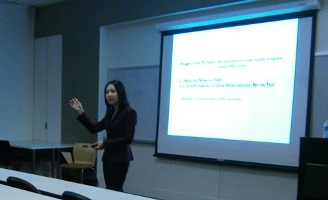
|
10/5/2012
128 MH
10:00-11:30 AM
|
Carmen Liutec
Houston
|
"Investigating New Product Purchase Behavior: A Multi-Product Individual-Level Model for New Product Sales"
-
Click to read Abstract
We develop a novel approach for modeling new product trial and early repeat purchase behavior, and we apply this approach in the context of consumer packaged goods. Our approach takes advantage of the cross-individual, cross-product, cross-time ata that is increasingly available from retail customer relationship management programs as well as research panels. It enables us to account for differences in consumers' intrinsic preferences for new products as well as their responsiveness to marketing variables, during both trial and early repeat purchases.
By leveraging these uncovered individual differences, we attempt to achieve three goals. First, we aim to improve the accuracy of post-launch sales forecasts based on data from a period that can be as short as two to three months, tapping into the fact that each individual trial or early repeat purchase observed during the post-launch period sends a different signal about the new product's sales potential. Second, we aim to provide more informative diagnostics for managers to act upon (e.g., how to re-position the new product or target it for a particular consumer segment). Finally, we aim to establish empirical regularities regarding consumer responses to new products (for example, how an individual's willingness to try new products may be related to his tendency to make repeat purchases, or how consumer price sensitivity may differ between trial and repeat purchases).
|
|
10/1/2012
126 MH
10:00-11:30 AM
|
Sunaina Chugani
UT Austin
|
"All Eyes On You: The Social Audience and Hedonic Adaptation"
-
Click to read Abstract
Research on general happiness has shown that significantly positive life events tend to maintain their positivity for longer periods of time when they involve social interactions. I examine a more common situation in the domain of product consumption, i.e., the presence of others during consumption, and test whether hedonic adaptation (i.e., the process by which happiness naturally declines over time) to products is moderated by a public context. Four studies reveal that both the presence of others and simply being aware of that presence slows down adaptation to products. Evidence suggests that the primary driver of this effect is consumers imputing that the "social audience" admires their product, and this sense helps maintain initial product happiness level over time. In fact, when consumers perceive that others look down on a product, adaptation to that product increases in the presence of a social audience.
|
|
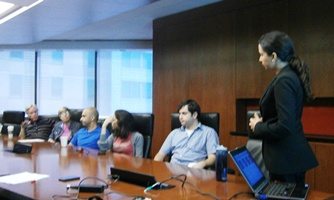
|
9/21/2012
126 MH
10:00-11:30 AM
|
Lily Lin
UBC
|
"Do the Crime, Always Do the Time? Insights into Consumer-to-Consumer Punishment Decisions"
-
Click to read Abstract
Norm violations disrupt social order, and based on prior research, social order can be restored through the punishment of norm violators. Based on this conceptual framework, the current research examines a prevalent yet overlooked behavior in the consumer literature by showing that consumers play an active role in making punishment decisions. Importantly, this paper highlights three factors that impact the balance in social order and thus are critical in consumer-to-consumer punishment decisions. First, when a third party in the consumption environment restores social order through punishment, consumers will refrain from punishing further (study1). Second, punishment is mitigated when the norm violator faces an unjustified adversity as punishment would create a further imbalance in social order (studies2a/b). Third, the level of punishment required to achieve social order is reduced for a higher status norm violator (study3). Finally, this paper identifies multiple avenues for future research that build on the current work.
|
|
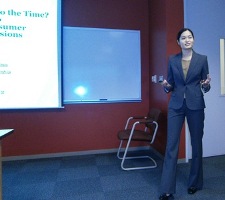
|
9/7/2012
126 MH
10:00-11:30 AM
|
Jordan Etkin
Maryland
|
"From One to Many: Multiple Means and Multiple Goals"
-
Click to read Abstract
Compatibility between the degree of similarity among means to goal attainment and the anticipated timing of goal pursuit increases goal-directed motivation. Six studies demonstrate that consumers are more motivated and willing to pay for means to goal attainment in the near term when they plan to use a set of different (vs. similar) means. In contrast, consumers are more motivated and willing to pay for means to goal attainment in the long term when they plan to use similar (vs. different) means. For example, consumers paid more for a personal training session when told it would include exercises for different (similar) muscle groups and would take place this week (next month). These effects are driven by the ease of processing differences (similarities) when considering the near (far) future (Förster 2009). Similar results were obtained across various domains, including health and fitness, saving money, and academic performance.
|
|
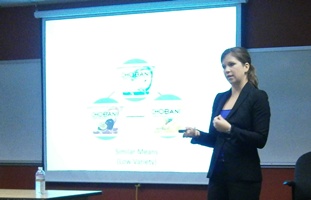
|
4/6/2012
126 MH
10:30-12:00
|
Thomas Steenburgh
Harvard
|
"Do Bonuses Enhance Sales Productivity? A Dynamic Structural Analysis of Bonus-Based Compensation Plans"
-
Click to read Abstract
We estimate a dynamic structural model of sales force response to a bonus based compensation plan. The paper has two main methodological innovations: First, we implement empirically the method proposed by Arcidiacono and Miller (2011) to accommodate unobserved latent class heterogeneity with a computationally light two-step estimator. Second, we estimate discount factors in a dynamic structural model using field data. The key to identification of discount factors is that bonuses affect only future payoff in non-bonus periods providing exclusion restrictions on current payoffs. Further, we exploit differences in predicted effort (and thus sales) over time from the exponential and hyperbolic discounting models to identify present bias in a hyperbolic discounting model. Substantively, the paper sheds insights on how different elements of the compensation plan enhance productivity. We find evidence that: (1) bonuses enhance productivity across all segments (2) overachievement commissions help sustain the high productivity of the best performers even after attaining quotas and (3) quarterly bonuses help improve performance of the weak performers by serving as pacers to keep the sales force on track to achieve their annual sales quotas. We also find clear evidence of hyperbolic discounting by salespeople.
|
|
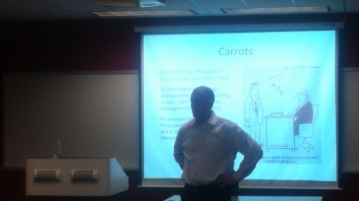
|
3/23/2012
126 MH
10:30-12:00
|
Tony Cui
Minnesota
|
"Fairness Ideals in Distribution Channels"
-
Click to read Abstract
Existing research suggests that concerns for fairness may significantly affect the interactions between firms in a distribution channel. We analytically and experimentally evaluate how firms make decisions in a two-stage dyadic channel, in which firms decide on investments in the first stage and then on prices in the second stage. We find that firms'' behaviors differ significantly from the predictions of the standard economic model. We explain the results by allowing the retailer to concern distributive fairness with the manufacturer. Using a Quantal Response Equilibrium (QRE) model, in which both the manufacturer and retailer make noisy best responses, we show significant concerns exist regarding fairness between channel members. Additionally, we propose a new principle of distributive fairness?the sequence-aligned ideal, that is studied first time in literature, and compare the new fairness ideal with several existing ideals in literature. Surprisingly, the new ideal, according to which the sequence of moving determines the formation of equitable payoff for players, significantly outperforms other fairness ideals, including strict egalitarianism, liberal egalitarianism, and libertarianism.
|
|
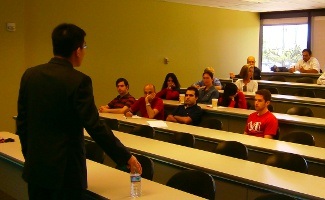
|
3/9/2012
126 MH
10:30-12:00
|
Jonah Berger
Wharton
|
"How Interest Shapes Word-of-Mouth Over Different Channels"
-
Click to read Abstract
Consumers share word-of-mouth face-to-face, online, and through various other channels. But do these channels shape what people talk about, and if so, how? Analysis over of 21,000 conversations as well as a laboratory experiment demonstrates that norms of conversation channel continuity impacts what gets discussed. While one might expect that more interesting products are talked about more than boring ones, this is only true in discontinuous conversation channels (e.g., online posts or text). In these channels, pauses between conversational turns are expected, so people have time to select and craft what they say. In channels where conversations are expected to occur more continuously (e.g., face-to-face or on the phone), however, there is less time to selectively pick what one talks about. Consequently, more interesting products are not talked about more frequently than less interesting ones. These findings shed light on what drives word-of-mouth and how companies can design effective word-of-mouth campaigns.
|
|
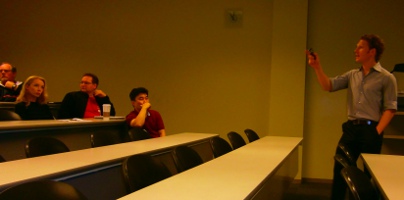
|
3/2/2012
126 MH
10:30-12:00
|
Upender Subramanian
UT Dallas
|
"The Strategic Value of High-Cost Customers"
-
Click to read Abstract
Many firms today manage their existing customers differentially based on the profit potential, providing fewer incentives to less profitable customers. While researchers and industry experts advocate this practice, firms have met with mixed results. In this paper, we examine this practice explicitly accounting for competitive customer poaching, and find that some conventional prescriptions may not hold under certain conditions. We analyze a setting where customers differ in their cost-to-serve and a customerís cost-to-serve may be known only to her current firm. We find that while high-cost customers are less profitable when viewed in isolation, they may be strategically valuable they enable a firm to earn higher profits from its other customers by creating an adverse selection problem for the rival, which discourages customer poaching. Consequently, under certain conditions, we find that some customers may be more valuable when they are less profitable, and it may be optimal to offer better incentives to less profitable customers than to more profitable customers and even retain unprofitable customers. Our results suggest that, in competitive settings, traditional customer lifetime value metrics may need to be modified to account for the competitive externality that actions towards some customers may impose on the cash áows from other customers. Our findings further suggest that firms may need to shift from a segmentation mindset, that views each customer in isolation, to a portfolio management mindset, that recognizes that the value of customers is interlinked.
|
|
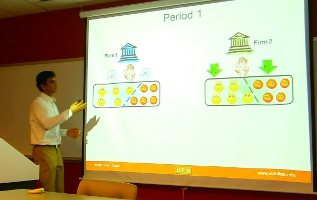
|
2/24/2012
126 MH
10:30-12:00
|
Keith Wilcox
Babson
|
"Are Close Friends the Enemy? Online Social Networks, Narcissism, and Self-Control"
-
Click to read Abstract
Online social networks are used by hundreds of millions of people every day, but little is known about their effect on behavior. In six studies, we demonstrate that social network use leads people to adopt a narcissistic mindset. This mindset remains active after social network use such that people show narcissistic tendencies after they have logged-off the social network. Specifically, we show that having people browse a social network leads them to subsequently display poor self-control and defensive self-enhancement, behaviors associated with narcissism. Additionally, we present evidence suggesting that social network use may have a negative effect on well-being. In particular, our research shows that greater social network use is associated with a higher body-mass index, increased binge eating, a lower credit score and higher levels of credit card debt for individuals with strong ties to their social network.
|
|
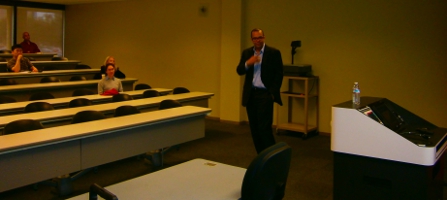
|
2/17/2012
126 MH
10:30-12:00
|
Dina Mayzlin
Yale
|
"Promotional Reviews: An Empirical Investigation of Online Review Manipulation"
-
Click to read Abstract
In the last ten years we have witnessed the proliferation of online consumer reviews of products and services. While reviews are clearly popular and have been shown to be impactful, there have always been concerns about the authenticity of online user reviews since firms can manufacture positive reviews for their own products and negative reviews for their rivals. The presence of undetectable fake reviews may have at least two deleterious effects on firms and consumers. First, consumers who are "fooled" by the manufactured reviews may make suboptimal choices. Second, the presence or potential presence of biased reviews may lead consumers to mistrust reviews. This results in consumers relying on review opinions less than they would if they could be assured that the reviews were unbiased. In order to examine the potential importance of these issues, we undertake an empirical analysis of the extent to which fakery occurs and the market conditions that encourage or discourage promotional reviewing activity. Specifically, we examine hotel reviews, exploiting the organizational differences between two travel websites: Orbitz and TripAdvisor. That is, while anyone can post a review on TripAdvisor, a consumer could only post a review of a hotel on Orbitz.com if she consumer actually booked at least one night at the hotel through the website. Thus, the cost of posting a fake review on Orbitz.com is quite high relative to the cost of posting a fake review on TripAdvisor. We examine differences in the distribution of reviews for a given hotel between TripAdvisor and Orbitz. We examine three hypotheses. First, drawing from the literature on organizational form, we show in a simple model that the costs of posting fake reviews is likely to be higher and the benefits lower for the manager of a hotel that is part of a chain than it is for an independent hotel. Second, we present a simple model that shows that the benefits from fakery are higher in situations in which the market is more competitive. Third, following Mayzlin (2006), we hypothesize that lower quality hotels have more incentive to engage in promotional reviews. Our empirical results are consistent with review manipulation.
|
|
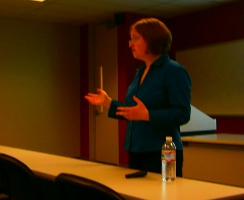
|
2/10/2012
126 MH
10:30-12:00
|
Angela Lee
Northwestern
|
"The Role of Perspective Taking in Embodied Cognition"
-
Click to read Abstract
The results of four studies show that the extent to which people's judgment and behaviors are influenced by environment cues are moderated by their perspective taking. We show that high perspective taking participants exposed to weight loss strategies (study 1) and marathon runners (study 2) versus those in the control condition evaluated products that facilitate a weight loss goal or a running goal more favorably and products that impede a weight loss goal or running goal less favorably. These effects were not observed among the low perspective takers. Study 3 provides evidence that the effect of perspective taking on judgment is mediated by people''s propensity to embody cognition in particular, we show that high perspective takers exposed to marathon runners were less able to squeeze a handgrip relative to their low perspective taking counterparts. In Study 4, we provide further evidence that embodiment influences persuasion by showing that high perspective takers responded more favorably to high imagery appeals than low perspective takers perspective taking had no effect on participants' response to low imagery ads.
|
|

|
2/3/2012
126 MH
10:30-12:00
|
Jennifer Argo
Alberta
|
"Naughty or Nice? The Trickledown Impact of Social Treatment on Prosocial Consumer Behavior"
|
|
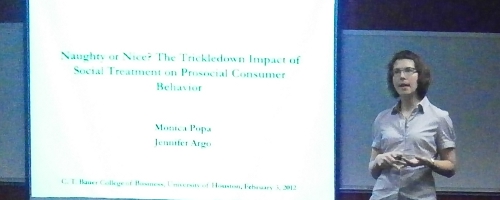
|
1/27/2012
126 MH
10:30-12:00
|
Paul Bloom
Duke
|
"Scaling Social Entrepreneurial Ventures: Theoretical and Empirical Insights"
|
|

|